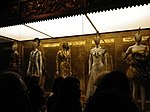Statue of Alexander Hamilton (Central Park)
1880 sculpturesGranite sculptures in New York CityMonuments and memorials in ManhattanOutdoor sculptures in ManhattanSculptures by Carl Conrads ... and 4 more
Sculptures in Central ParkSculptures of men in New York CityStatues in New York CityStatues of Alexander Hamilton

An outdoor granite sculpture of Alexander Hamilton by Carl Conrads is installed in Central Park, Manhattan, New York. Hamilton's son, John C. Hamilton, commissioned Conrads to sculpt this statue, which was dedicated on November 22, 1880, and donated to the city. Conrads used the bust of Hamilton created by the sculptor Giuseppe Ceracchi as a model for Hamilton's head.American founding father Alexander Hamilton lived nearby in Manhattan, at Hamilton Grange, when he died in 1804.
Excerpt from the Wikipedia article Statue of Alexander Hamilton (Central Park) (License: CC BY-SA 3.0, Authors, Images).Statue of Alexander Hamilton (Central Park)
East Drive, New York Manhattan
Geographical coordinates (GPS) Address Website Nearby Places Show on map
Geographical coordinates (GPS)
| Latitude | Longitude |
|---|---|
| N 40.781027777778 ° | E -73.964555555556 ° |
Address
Alexander Hamilton
East Drive
10021 New York, Manhattan
New York, United States
Open on Google Maps









